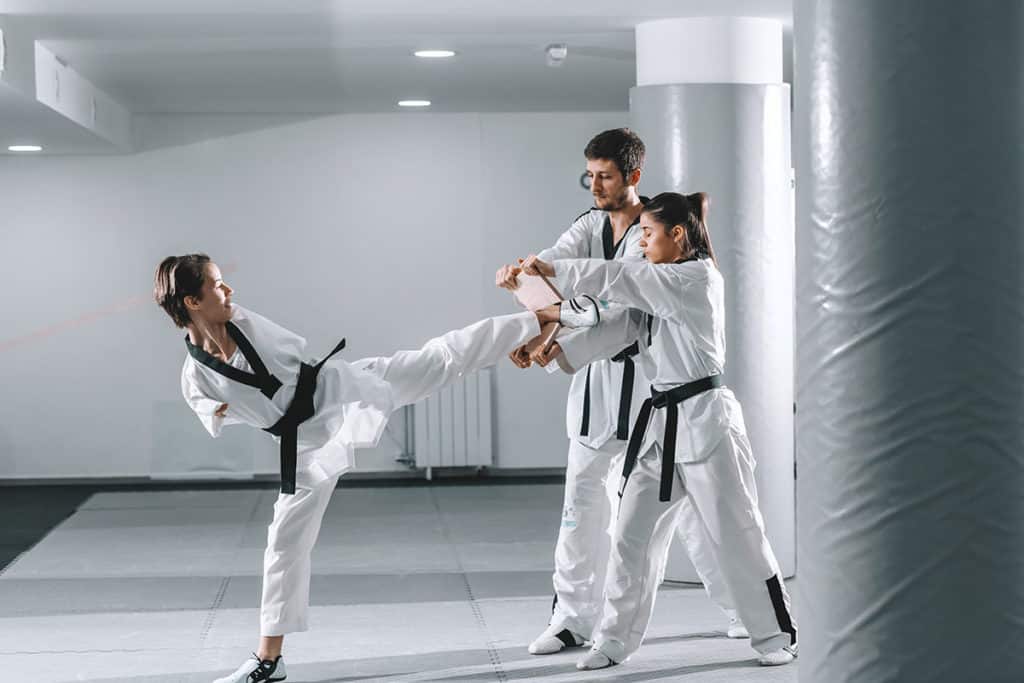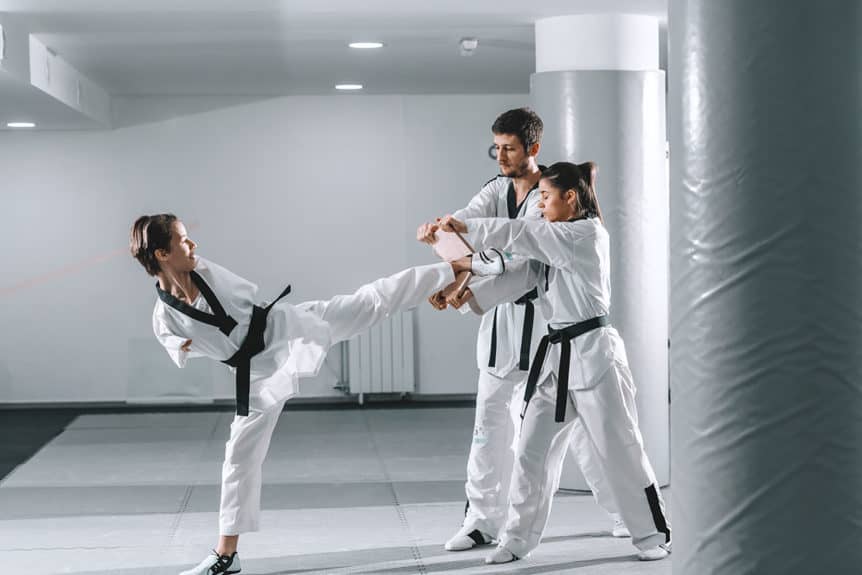
Para Taekwondo competitors for the Paralympics are judged in both sparring (Kyorugi) and forms (Poomsaes). In the Para Taekwondo Olympics hitting a fellow player on the head or using punches are prohibited and will be considered fouls.
Para Taekwondo is both rewarding and fun for those with disabilities. The chance to compete against others at the Paralympics has it own special rewards and satisfaction. I did some research on the competitors and the events and this is what I found.
Para Taekwondo comes from traditional Taekwondo and has been modified to allow for people with physical impairments in their upper limbs to compete against one another.
Well explore more about the history and inclusion of Para Taekwondo in the Paralympics including information on how to qualify, the scoring and much more so lets get started!
History of Para Taekwondo
Para Taekwondo was established by the World Taekwondo in 2005 to accommodate athletes with disabilities. It was, however, until 2009 when the first-ever Para Taekwondo World Championship took place in Baku, Azerbaijan.
Since then, it has been held in St. Petersburg, Russia (2010), Santa Cruz, Aruba (2012), Lausanne, Switzerland (2013), Moscow, Russia (2014), and Samsun, Turkey (2015).
Thanks to its popularity in terms of athletes and spectators, the Para-Taekwondo has become a permanent fixture in the WTF calendar. It now features more than 120 athletes from over 35 countries and the number is expected to increase at the Tokyo 2020 games.
This is after the Para-Taekwondo was incorporated as a full member of the International Paralympics Committee (IPC) in 2015.
Para Taekwondo and the Paralympics
Although Taekwondo became a full Olympic sport in 2000, the sport has never been fully inclusive at the highest level. In other words, Taekwondo has never been accommodative of athletes with impairments but this is now changing thanks to its introduction to the 2020 Tokyo Paralympics. Alongside Badminton, Taekwondo will be making its debut as a new sport at the Tokyo 2020 Paralympics Games.
Known as Para Taekwondo, this sport was established by the World Taekwondo Federation (WTF) in 2005 as a way of including athletes with disabilities in the great sport of Taekwondo.
The main aim of Para Taekwondo is to make Taekwondo a fully inclusive form of martial arts. Given that Taekwondo has various classifications tailored for both younger and older students, it would only be appropriate if it had a category for disabled students.
So instead of being a sport that only focuses on training the physically fit, the introduction of Para Taekwondo now means that the disabled in our communities now have a great platform to showcase their abilities at the world’s biggest stage.
Paralympics Classifications
Para-Taekwondo is structured in such a way that it offers worldwide competitions for athletes of all impairments. In short, athletes are classified based on the nature and degree of their impairments. This is essential in preventing a scenario where an athlete with the least limiting impairment as an advantage over the opponent.
Depending on an athlete’s impairment, the athlete can compete in one or both disciplines. For instance, athletes with intellectual impairments, neurological impairments, and visual impairments can compete in Poomsae (classified with a ’ prefix).
On the other hand, athletes with upper limb impairments can compete in Kyorugi (classified with a ’ prefix). Given that Para Taekwondo is still considered to be at its infancy, only Kyorugi will be featured at the Tokyo 2020 games.
In classifying athletes, a classification panel will evaluate athletes and categorize them based on whether or not their (athletes) eligibility impairments meet the minimum criteria required to participate in Para-Taekwondo. As such, Para Taekwondo is classified based on:
- Visual impairment – P10
- Intellectual disability – P20
- Neurological impairments – P30
- Wheelchair – P50
- Short stature – P70
- Limb(s) deficiency and/or impaired passive range of movement – K40
- Deaf – KP60
Keep in mind that each major category is subdivided into further categories. For example, K40 has sub-categories K41, K42, K43, K44 and so on. In terms of age and gender, there are both male and female divisions, as well as junior categories (12-15 years old), under 30 (16-29 years old), and over 30 (30 years old and older). For a player to participate in a Para-Taekwondo event sanctioned by the WTF, he/she MUST be classified.
As we noted earlier, Tokyo 2020 will only feature Kyorugi and here are some categories to expect.
- K44 (+K43) +58kg (Women)
- K44 (+K43) -58kg (Women)
- K44 (+K43) -58kg (Women)
- K44 (+K43) -61kg (Men)
- K44 (+K43) -75kg (Men)
- K44 (+K43) +75kg (Men)
How to Qualify for the Paralympics
The qualification for Para-Taekwondo is allocated not to the individual athlete but to the NPC (National Paralympic Committee), in this case, a given country.
An NPC is allocated a maximum of 3 male and 3 female qualification slots provided that the slots are filled by athletes ranked in the top-20 in their sports class and weight category in the WTF Para Taekwondo worldwide ranking list five months prior to the games.
In other words, an athlete may qualify for the Para Taekwondo if he/she is among the top 20 best players in his/her class and weight category 5 months before the games.
To be eligible, an athlete must:
- Be a holder of the WTF for the current year
- Internationally classified with a confirmed’ sport class status
- Be a holder of a Taekwondo Dan
- Be at least 16 years old
- Have competed in at least one competition sanctioned by the WTF between 1 January 2018 and 30 April 2020
Rules of Para Taekwondo at the Paralympics
The main rule when it comes to Para Taekwondo is that any kick or punch to the head is forbidden and considered a foul. For this reason, only kicks to the trunks will earn athletes points. Here are the three kicks to the trunk that can earn an athlete points.
- 2 points for a valid kick on the trunk
- 3 points for a 180-degree turn kick, and
- 4 points for a 360-degree turn kick
The four-pointer 360-degree turn kick was only introduced to the sport in 2017. The main aim of this move is to enable athletes to master this important Taekwondo move, which can help them mount an incredible comeback from a losing position. Keep in mind that the opponent is awarded one point for every penalty deduction.
Like mainstream Taekwondo, kicks are the main cog of this martial art. However, athletes are also encouraged to master their defensive skills not just to guard against the opponent’s attacks but also to prevent the opponent from earning points.
A Para Taekwondo competition has three two-minute rounds with a minute rest period between the rounds. If the tie is level after the three rounds, the fourth or golden-point round is added to decide the winner.
Like other Paralympic sports, Para Taekwondo follows a simple routine where athletes compete in a head-to-head format for qualification. The best-placed athletes then move to the knockout stages until the last two remaining athletes compete for gold.
Final Thoughts
To this end, it is very clear that the rapid and exciting rise of Para-Taekwondo will continue beyond the 2020 Tokyo games. The need to make Taekwondo an all-inclusive martial art where athletes aren’t be barred from competing based on their physical disabilities is certainly behind this great movement.

